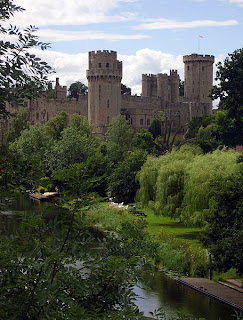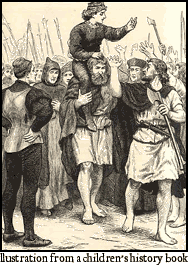Do you have a glamorous view of history? Do you think that
the Anne and Isobel Neville lived exciting, dazzling lives or were controlled
as pawns in a high risk political game? Much of how we perceive our past has
been shaped by films, TV and historical novels where handsome knights romance
beautiful ladies in gorgeous frocks. The reality, however, was somewhat
different. For most ordinary people,
life consisted of hard work, little education, poor healthcare and hygiene and
very few chances to get ahead in life. For women it was even harder, as they
were viewed as possessions of their families and were married off as
advantageously as possible. Love was not
considered to be a factor; even liking your future spouse was not taken into
consideration in many cases. The life of
a poor woman consisted of hard work, marriage, bearing children and struggling
to bring them up. Infant mortality was
high and women had large families, where sometimes very few of the children
reached adulthood.
 |
| Richard III and Anne Neville, Rous Roll |
But what if you were a princess or born into an aristocratic
family like Anne and Isobel Neville?
Surely then your life would have been more like the Hollywood movie? Not
really, is the answer. Royal and noble
women in medieval times were still controlled by their family. They would have been reared with the skills
to run a large household and be a mother, but they probably had been betrothed
at a young age to someone they might not even have met. Their lives would have been more comfortable
and they would have the beautiful gowns and jewels, but their lives could still
be cut cruelly short by disease or death in childbirth.
So let’s have a look at the lives of these two sisters in 15th
century England, who on the surface of things seemed to have had such romantic
and exciting lives? Isobel and Anne Neville were both born at Warwick Castle;
Isobel in 1451 and Anne in 1456. Their
parents were Richard Neville, Earl of Warwick and his wife Anne Beauchamp. The couple were to have no further children
and this would be a grievous blow to the Earl as it meant that he had no heir. Girls
at that time could inherit property and estates, but not carry on the title. Both
of the girls spent much of their childhood at Middleham Castle in Yorkshire in
the company of Richard the young Duke of Gloucester, George Duke of Clarence
and Francis Lovell. Their childhood was
played out against the violent backdrop of the War of the Roses and they were
both to become pawns in the struggle for the throne.
The Earl of Warwick supported the claim of Edward of York
and helped him onto the throne as King Edward IV. Edward was the elder brother of George of
Clarence and Richard of Gloucester, and this is why Warwick took them into his
household and was keen for them to become close to his daughters. He was looking to consolidate his power by
marrying them to the two royal princes, who at this time were still Edward’s
heirs. The Earl of Warwick became
dissatisfied with his rewards for helping Edward IV gain the throne and was
outraged when he married the widow Elizabeth Grey, humiliating him as he was
negotiating an alliance for Edward with a French princess. He was desperately unhappy with the amount of
titles, lands and money that Edward lavished on his new wife’s family and what
he regarded as the new Queen’s grasping, avaricious nature.
In 1469 Isobel was betrothed to George of Clarence. This was against the king’s wishes as he
believed that the union would bring too much power and influence to Warwick.
Because of Edward’s disapproval, Warwick took the young couple to Calais where
they were married on 11th July 1469 by Warwick’s brother George
Neville, Archbishop of York. The Duke of
Clarence turned traitor against his brother the King and threw his lot in with
Warwick and the Lancastrians who were plotting to overthrow Edward IV and
restore Henry VI to the throne.
At this time the
Lancastrian forces were led by Henry VI’s wife Marguerite of Anjou, and to
cement their alliance the Earl of Warwick offered his 14 years old daughter
Anne in marriage to the 17 year old Prince of Wales. They were formally betrothed at the Chateau
d’Amboise with the blessing of the French king.
The Earl of Warwick had Anne’s sister Isobel in his train along with her
traitorous husband George, Duke of Clarence.
However, after Anne was married to Edward, Prince of Wales,
Clarence perceived this to be a snub to him and his pretensions to power. So he threw himself on his brother’s mercy
and betrayed Warwick to return to his brother’s side with his large army. Marguerite of Anjou had been suspicious of
Warwick’s motives because of Clarence’s presence, but Warwick returned to
England to fight to restore Henry VI to the throne. He was initially successful but was
eventually killed at the Battle of Barnet early in 1471.
Anne Neville returned to England with Marguerite and Edward, but
their army was defeated at the Battle of Tewkesbury in May 1471. Her young husband was killed and she was
imprisoned along with Marguerite. It
has been argued that Richard of Gloucester was closely involved in the death of
the young Prince of Wales, as he himself wanted to marry Anne. Again it has
been argued that this was because he was in love with her or, more cynically
perhaps, that it was because he wanted to get his hands on the estates and
possessions of her late father and her mother’s vast Beauchamp inheritance. She
was taken first to Coventry and then to the household of her sister and
brother-in-law, the Duke of Clarence who was once more back in the Yorkist
fold.
Richard of Gloucester asked his brother Edward IV for Anne’s hand in marriage, which outraged Clarence who believed that he should get the lion’s share of the Warwick estates and titles. There is a story that Anne was either so scared of Clarence that she ran away and worked as a kitchen maid in a chophouse in the city or was put there by the Clarence to keep her out of Richard’s hands. Richard supposedly tracked her down and placed her in sanctuary at Westminster Abbey until they could be married on 12th July 1472, with the King’s blessing. Richard was allocated much of Warwick’s former estates after his marriage. He was also appointed Governor of the North and the young ducal couple spent most of their time at Middleham Castle. Their only child, a son called Edward, was born there some time in 1473.
 |
| Warwick Castle |
The Clarence’s first child was stillborn, but in 1473 their
daughter Margaret was born and in 1475 she was followed by their son Edward. Tragically, Isobel died the following year at
the very young age of 25, probably from consumption. After Isobel’s death, Clarence continued to
plot against his brother the King and was finally imprisoned in the Tower of
London. He was executed privately there
in 1478 and there is a legend that he was killed by being drowned in a butt of
Malmsey wine. Anne Neville, as their
aunt, took his two young children into her care. Isobel and George’s son Edward later became
Earl of Warwick and Earl of Salisbury, but historians believe that he may have
had learning difficulties. After the
Battle of Bosworth, Henry VII kept him in prison because of his claim to the
throne and he was executed in 1499 supposedly because he had been plotting to
escape with the pretender Perkin Warbeck.
Their daughter Margaret was married to Sir Richard Pole and had five
children and she was allowed to take the title Countess of Salisbury. When she was 67 year old she was charged with
treason by Henry VIII and beheaded.
There is a story that she refused to lay her head on the block and that
the inexperienced executioner had to strike her with his axe ten times before
he managed to kill her.
Edward IV died prematurely in 1483, and after confronting
the Woodville’s and declaring his two nephews illegitimate, Richard took the
crown and Anne was crowned Queen and their son Edward created Prince of
Wales. Edward tragically died suddenly
at Sheriff Hutton Castle in April 1484 at the age of 11. His mother Anne was already suffering from
consumption and seemed unlikely to bear another child. Rumours apparently sprang up at the Court
that Richard was planning to divorce Anne and marry his niece Elizabeth of York.
When Anne Neville died in March 1485 at the young age of 28, more rumours arose that
Richard had poisoned her so that he could marry a healthy young wife who could bear
him an heir. Anne Neville died in the
Palace of Westminster during an eclipse of the sun. She was buried in an unmarked
grave in Westminster Abbey, and there was no memorial for her until in 1960 the
Richard III Society installed a bronze tablet.
Her husband, Richard III died a few months later during the Battle of
Bosworth, ending the rule of Plantagenet kings in England.
So however entrancing the lives of these two
women may seem to have seemed on the surface, in reality they both died
tragically young, after suffering from consumption (tuberculosis). In their short lives they had been used as
political pawns first by their father, the Earl of Warwick and then by the two
Plantagenet brothers they were married to.
They knew the heartache of losing children at a young age and had had to
bear the grief of the deaths of many of their close relatives and companions on
the battlefield or on the scaffold, including their own father and Anne’s
youthful first husband. Their stories make a good historical tale, but did they
have a happy, fulfilled life?
Richard III family image Wikimedia Commons Public Domain
Warwick Castle Image Roland Turner Wikimedia Creative Commons Attribution Share Alike 2.0 Generic




